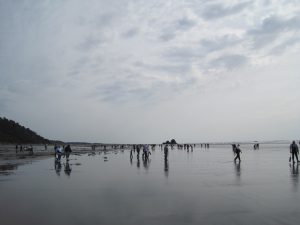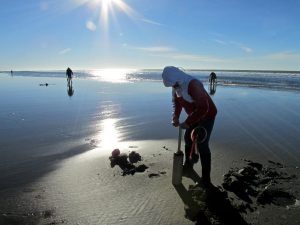Out on the Washington Coast, far from the hustle and bustle of life along the I-5 corridor, a family-friendly activity is awaiting your discovery. The weather is likely gray and the daylight hours dwindle, signs that the great razor clam digging season is upon us. For many hearty Pacific Northwest residents, flocking to the coast during low tides becomes a tasty adventure. With hopes to get their limit of delicious mollusks, those who hit the coast discover that clam digging is a fun, cheap and family-friendly activity that will provide delicious meals and incredible memories.
To clam dig this year, all you need is a permit, an implement to dig the clams and a container to put the clams in once you have found them. Before heading out and attempting to dig razor clams, there are a handful of tips and things to know to ensure that you are clamming in a safe, healthy and legal manner.
What to Bring

Permit
Without a permit, you can’t clam dig. All diggers age 15 or older are required to have a 2017-18 license to harvest razor clams on any beach. You can choose a license based on how long you plan on going clamming this season. Your choices are between a three-day razor clam license or an annual combination clamming and fishing license. These licenses are available on WDFW’s website and from license vendors around the state. Each clam digger is allowed to take up to 15 razor clams per day. It is important to note that you are legally required to keep the first 15 razor clams you dig, no matter the size or condition, and that each digger must keep their clams in their own container.
Clamming Tools
To dig a razor clam, you have two options for retrieving it out of the sand. Your choices are between using a shovel or a clam “gun.” The clam gun is a metal or PVC tube that you twist into the group and pull out the sand all around the clam by putting your thumb over a small hole. Beginning clammers should use a clam gun, as it is the easiest and simplest method of getting your limit. More advanced clam diggers use shovels, but know that a shovel requires a bit of patience and practice before you can dig a clam with ease. The WDFW website has tips and videos on how to use both a shovel and a clam gun. Once you get a clam out of the sand, each clam digger is required to have a separate container for their clams.
Warm clothes
After obtaining permits for you and your family, make sure that you are properly outfitted for clam digging. During the fall and winter clam digging season, the best tides are at night, meaning that you will more than likely be cold and wet. At the minimum, you need to have a sturdy pair of rubber boots, good rain pants, a warm hat and a trusty rain jacket. You will also need to bring a lantern or headlamp. Remember to layer your gear in case the weather gets nicer, but always assume it will be wet and cold. Do not head out unprepared.

Where and When to Go Clamming
Numerous destinations are open for clam digging, depending on the year. Stretching from Kalaloch Beach in the Olympic National Park down to the southern end of the Washington Coast along the mouth of the Columbia River, there are a handful of beaches that make for excellent digs. Before you leave to go clam digging, make sure that the beach you are planning to go to is open for clamming on the scheduled days. Beaches can close to clamming. Before heading out, it is also important to check the time of the upcoming tides. The lower the tide, the better clamming. Most clam digging dates are centered around the lower tides. It is important to note that during the fall and winter digs, the low tides take place in the dark, when it is often rainy and cold. Spring tides allow for daylight clam digging with a potential for better weather, but most serious clammers go during the fall and winter season.
A full list of open beaches and clamming dates can be found on the Department of Fish and Wildlife’s (WDFW) website. Please follow all rules and regulations about driving on the beaches.
- The Long Beach region starts at the mouth of the Columbia River and heads north, all the way to the mouth of the Willapa Bay.
- The Twin Harbors region extends from Willapa Bay north to the south jetty at the mouth of Grays Harbor, found in Westport.
- The Copalis Beach region stretches from the north jetty at the mouth of Grays Harbor in Ocean Shores all the way north to the Copalis River.
- The Mocrocks region sits between the Copalis River as the south boundary and runs north until it reaches the boundary of the Quinault Indian Reservation.
- The Kalaloch region runs from the South Beach campground, all the way north to Olympic National Park’s Beach Trail 3. Keep in mind that this beach is often closed to harvest.
How to Find a Clam

The key to a successful clam dig is to start digging before the low tide. Starting early and following the tide as it goes out, look for signs of clam activity. Ideal conditions for clamming are when the clams are necking, or sticking their necks out of the sand. If you see this, consider yourself lucky.
More than likely, you will encounter one of three marks of a clam while looking at the beach. They are a dimple, which is a depression in the sand; a doughnut, which has a small hole and raised sides; and a keyhole, which usually occurs in drier sand and looks like an hourglass or hole. Since you have to keep all clams you dig, remember that the larger sized holes usually indicate the larger clams. After spotting the signs of a clam, you’ll need to be quick, as razor clams can burrow at a fast pace in soft, watery sand. Once you successfully dig your clam, be careful grabbing it, as their shells are the reason they are called razor clams. After carefully placing it in your container, continue until you have your limit of 15 clams per person, per day.
Sponsored





































